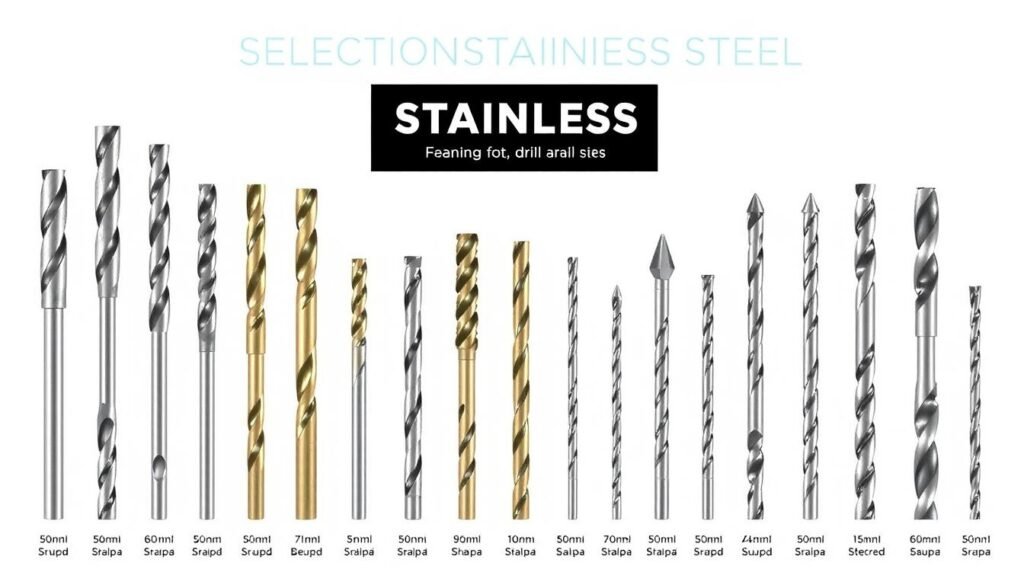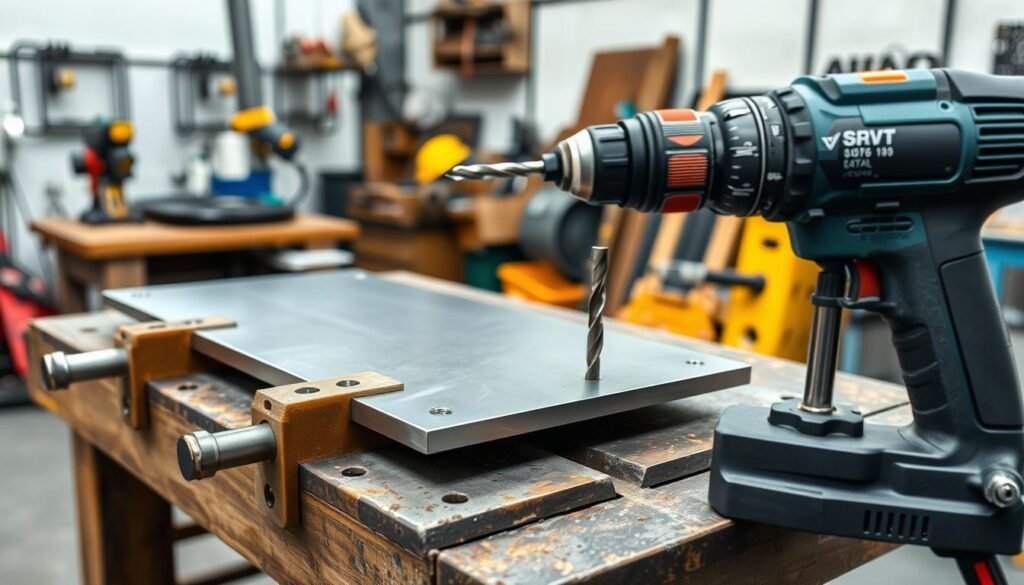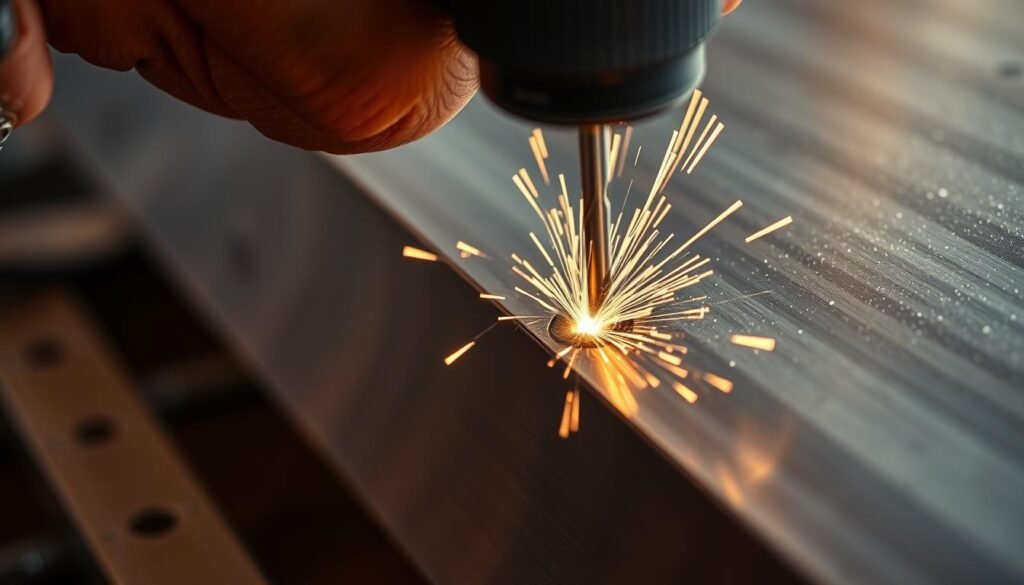Drilling into stainless steel can be a daunting task due to its hardness and resistance to corrosion. Unlike other metals, stainless steel requires specialized techniques and tools to achieve clean, precise holes.
This comprehensive guide is designed to walk you through the process, from understanding the unique properties of the material to troubleshooting common issues that may arise during drilling. With the right drill bits and a bit of practice, you’ll be able to tackle this challenging task with confidence.
Whether you’re a DIY enthusiast or a professional metalworker, mastering the skill of drilling into this durable metal opens up a world of possibilities for your projects.
Understanding the Challenges of Drilling Stainless Steel
The process of drilling stainless steel is fraught with challenges stemming from its inherent characteristics. To successfully drill through this material, it’s essential to understand the properties that make it difficult to work with.
Properties of Stainless Steel That Make Drilling Difficult
Stainless steel contains chromium and nickel alloys that provide excellent corrosion resistance but also make it significantly harder to drill than regular steel. The material’s high tensile strength requires more force to penetrate, creating challenges for standard drilling equipment and techniques. Additionally, stainless steel has poor thermal conductivity, causing heat to concentrate at the drilling point rather than dissipating through the material. This accumulated heat can quickly damage drill bits and potentially alter the material properties of the stainless steel workpiece.
Key Properties Affecting Drillability:
- High chromium and nickel content
- High tensile strength
- Poor thermal conductivity
| Property | Effect on Drilling | Drilling Challenge |
|---|---|---|
| High Chromium and Nickel Content | Increases hardness | Difficulty in penetrating the material |
| High Tensile Strength | Requires more force | Potential for equipment strain |
| Poor Thermal Conductivity | Heat accumulation | Risk of drill bit damage |
Work Hardening: The Primary Challenge
Work hardening occurs when mechanical stress causes the stainless steel to become significantly harder at the point of contact with the drill bit. This phenomenon creates a frustrating cycle where the more you drill, the harder the material becomes, making further drilling increasingly difficult. Work hardening can lead to premature drill bit dulling, excessive heat generation, and potential drill bit breakage if proper techniques aren’t employed. The work hardening effect is particularly pronounced in austenitic stainless steels (300 series), which are among the most common types used in consumer and industrial applications.
Professional machinists recognize that managing work hardening through proper speed, pressure, and cooling is the key to successful stainless steel drilling. By understanding these challenges and adapting drilling techniques accordingly, one can achieve more efficient and effective results.
Essential Tools and Equipment for Drilling Stainless Steel
Drilling stainless steel requires specialized tools to achieve precise results and maintain safety.

Selecting the Right Drill with Torque Limiter or Safety Clutch
When drilling stainless steel, using a drill with a torque limiter or safety clutch is essential for preventing injuries if the bit snags in the material. The torque limiter acts as a safety mechanism that stops the drill from spinning violently if the bit catches, protecting both the operator and the workpiece.
Power requirements for drilling stainless steel are substantial, so select a drill with sufficient torque and a variable speed control for optimal results.
Bench Drills vs. Hand-Held Drills
Bench drills provide superior stability and precision compared to hand-held models, making them the preferred choice for professional stainless steel drilling applications. The fixed position of a bench drill allows for more consistent pressure application and better control of drilling angles, resulting in cleaner holes.
Hand-held drills can be suitable for lighter stainless steel work but require greater operator skill to maintain consistent pressure and positioning.
Additional Tools and Accessories
Additional essential accessories include center punches for marking hole positions, clamps for securing workpieces, and cutting fluid applicators. A digital tachometer can be valuable for monitoring drill speeds to ensure you’re operating within the optimal RPM range for stainless steel.
Consider investing in a drill press vise with a swivel base for secure holding of irregularly shaped stainless steel pieces during drilling operations.
Best Drill Bits for Stainless Steel
When it comes to drilling stainless steel, selecting the right drill bit is crucial for achieving precise and efficient results.

Coated HSS Drill Bits with Titanium Aluminum Nitride
Titanium Aluminum Nitride (TiAlN) coated HSS drill bits are ideal for stainless steel due to their enhanced hardness and heat resistance properties. These specialized HSS bits can be identified by their distinctive golden color coating and are specifically designed to withstand the high temperatures generated when drilling stainless steel.
When purchasing coated HSS bits, be cautious of cheaper alternatives that are merely painted gold rather than properly coated with TiAlN, as these will quickly fail when used on stainless steel.
Cobalt Drill Bits for Hard Metals
Cobalt drill bits, containing 5-8% cobalt blended with high-speed steel, offer superior hardness and heat resistance compared to standard HSS bits. The cobalt content allows these bits to maintain their cutting edge at higher temperatures, making them excellent for extended drilling operations in stainless steel.
While more expensive than HSS bits, cobalt drill bits provide significantly longer service life when drilling stainless steel, offering better value for professionals and frequent users.
Carbide Drill Bits: When to Use Them
Solid carbide drill bits represent the premium option for drilling stainless steel, offering unmatched hardness and wear resistance. These bits are ideal for production environments where maximum efficiency and minimal downtime are required, though their brittleness makes them susceptible to breakage if not used with proper technique.
Professional Hole Saws for Larger Diameter Holes
For larger diameter holes in stainless steel, professional-grade hole saws with substantial steel construction and proper arbor attachments are essential. Effective hole saws for stainless steel feature a complete circular cutting edge with a pilot drill to maintain centering and prevent wandering during the cutting process.
Avoid using thin, flexible hole saws with incomplete cutting edges, as these are unsuitable for the demands of cutting stainless steel and may cause dangerous binding or tool failure.
Preparation Steps Before Drilling Stainless Steel
Successful drilling of stainless steel begins with thorough preparation and attention to detail. Proper preparation is crucial for achieving accurate and safe drilling results.
Marking and Center Punching Your Workpiece
Accurate marking of the intended hole location is the first step in preparing to drill stainless steel. Use a fine-point permanent marker or scribe to mark the spot. After marking, use a center punch to create a small indentation that will guide your drill bit and prevent it from wandering when you start drilling. For precision work, consider using a spring-loaded automatic center punch, which delivers consistent force for creating uniform starting points.
Properly Securing the Stainless Steel Material
Securing your stainless steel workpiece is essential for safety and accuracy. The material may catch and spin dangerously if inadequately clamped. Use heavy-duty clamps, a drill press vise, or specialized workholding fixtures to immobilize the stainless steel completely before beginning to drill. For thin stainless steel sheet, place a sacrificial wooden backing board underneath to prevent deformation and provide support as the drill bit breaks through.
Selecting and Applying the Right Cutting Fluid
Selecting the appropriate cutting fluid is critical for successful stainless steel drilling. Sulfurized cutting oils are particularly effective for this material. The cutting oil serves multiple crucial functions: reducing friction, dissipating heat, extending drill bit life, and improving the quality of the drilled hole. Apply cutting oil generously before beginning to drill and continue adding more throughout the drilling process. For vertical surfaces or overhead drilling, consider using a paste-type cutting compound.
| Cutting Fluid Type | Application | Benefits |
|---|---|---|
| Sulfurized Cutting Oil | General drilling | Reduces friction, dissipates heat |
| Paste-type Cutting Compound | Vertical or overhead drilling | Adheres to surface, maintains lubrication |
How to Drill Stainless Steel: Step-by-Step Process
The process of drilling stainless steel is multifaceted, demanding attention to detail and adherence to specific techniques to achieve optimal results. Drilling stainless steel effectively requires a comprehensive understanding of the factors involved, including the right equipment, appropriate drilling speeds, and proper technique.
Setting the Correct Speed: Low RPM is Key
When drilling stainless steel, setting the correct speed is crucial. The recommended RPM is significantly lower than for other materials, typically between 400-700 RPM for small diameter bits. Using low RPM is essential because high speeds generate excessive heat, accelerating work hardening and reducing drill bit life. For larger diameter bits (over 3/8 inch), it’s advisable to reduce the speed further to around 300-500 RPM to maintain control and prevent overheating.
- Use 400-700 RPM for small diameter bits.
- Reduce to 300-500 RPM for larger diameter bits.
Applying Consistent Pressure Without Forcing
Applying firm, consistent pressure is vital to keep the drill bit cutting continuously. Hesitation or intermittent pressure can promote work hardening of the stainless steel surface. However, it’s equally important to avoid forcing the drill, as excessive pressure generates heat and can cause the drill bit to bind or break in the material. Let the drill bit do the work at its own pace; pushing too hard is counterproductive and will slow down the overall drilling process by damaging the cutting edge.
Maintaining a Steady Drilling Technique
Maintaining a perfectly perpendicular position is crucial to ensure clean, accurate holes and reduce stress on the drill bit’s cutting edges. For deeper holes, employing the “peck drilling” technique is recommended—drilling in small increments of 1/8 to 1/4 inch, then withdrawing the bit completely to clear chips and allow cooling. This technique helps in managing heat and preventing drill bit failure.
Cooling and Preventing Heat Buildup
Throughout the drilling process, be vigilant about heat management, as excessive heat is the primary cause of drill bit failure and work hardening issues. Apply additional cutting fluid regularly during drilling, especially when you notice the existing fluid darkening or smoking, indicating it’s breaking down from heat. Consider taking short breaks during the drilling of deeper holes to allow both the bit and the workpiece to cool naturally, particularly when working with thicker stainless steel sections.
By following these steps and maintaining a focus on the drilling process, you can achieve precise and clean holes in stainless steel, enhancing the overall quality of your work.
Essential Safety Precautions for Drilling Stainless Steel
When working with stainless steel, safety should be your top priority to prevent potential hazards. Drilling stainless steel can generate flying metal chips, intense heat, and harmful fumes, making it crucial to follow proper safety guidelines.
Required Personal Protective Equipment (PPE)
To ensure safety while drilling stainless steel, it’s essential to wear proper PPE. Impact-rated safety goggles should be worn at all times to protect your eyes from flying metal chips and fragments. Additionally, heavy-duty work gloves are necessary to safeguard your hands from sharp metal edges and the intense heat generated during drilling. Consider wearing a face shield in conjunction with safety goggles when drilling larger holes or working with power drill presses.
Safe Handling of Hot Materials and Cutting Fluids
Both the drill bit and stainless steel workpiece can reach extremely high temperatures during drilling and remain hot for several minutes after completion. Never touch freshly drilled stainless steel with bare hands; instead, use pliers or allow sufficient cooling time. Be aware that cutting fluids and oils can produce potentially harmful fumes, so ensure adequate ventilation in your work area. For extended drilling operations, consider using a respirator rated for organic vapors.
Preventing Workpiece Movement and Drill Bit Snagging
To prevent accidents, it’s crucial to secure the workpiece properly. Use multiple clamps positioned strategically to resist both rotational and lifting forces during drilling. For thin stainless steel sheets, sandwich the material between wooden blocks before clamping to distribute pressure evenly. Maintain a stable stance with good balance when using a hand-held drill to ensure control if the drill bit suddenly catches.
| Safety Measure | Description | Benefit |
|---|---|---|
| Impact-Rated Safety Goggles | Protects eyes from flying metal chips | Prevents eye injuries |
| Heavy-Duty Work Gloves | Safeguards hands from sharp edges and heat | Reduces risk of hand injuries |
| Proper Workpiece Clamping | Secures workpiece during drilling | Prevents accidents due to workpiece movement |

Maintaining and Sharpening Drill Bits for Stainless Steel
Maintaining and sharpening drill bits is essential for achieving optimal results when drilling stainless steel. Regular maintenance not only improves drilling efficiency but also extends the life of your drill bits.
Signs Your Drill Bit Needs Sharpening
Identifying when your drill bit needs sharpening is crucial. Signs include increased pressure required to drill, excessive heat generation, and visibly worn cutting edges. A dull bit will show flattened or rounded edges instead of sharp, defined cutting surfaces.
Proper Sharpening Techniques for Different Bit Types
For HSS and cobalt bits, maintaining the original factory angle (typically 118 degrees for standard bits or 135 degrees for split-point bits) is crucial when resharpening. Use a bench grinder with a fine wheel and apply light pressure, frequently cooling the bit in water to prevent overheating. Carbide bits, however, require specialized diamond wheels and are often best sent to professional sharpening services.
Extending the Life of Your Drill Bits
To extend the life of your drill bits, store them properly in individual sleeves or bit organizers. After each use, clean your bits thoroughly with a solvent to remove metal particles and cutting oil residue, then apply a light coat of machine oil before storage. Rotating through multiple bits during extended drilling sessions can also help prevent overheating and prolong bit life.
Troubleshooting Common Problems When Drilling Stainless Steel
Effective drilling of stainless steel requires not only the right tools but also the knowledge to overcome common drilling issues. Despite proper preparation and technique, problems can still arise during the drilling process.
Addressing Work Hardening Issues
Work hardening is a common issue when drilling stainless steel, occurring when inconsistent drilling technique causes the material to become harder and more resistant to cutting. To address this, maintain continuous drilling with steady pressure and avoid stopping mid-hole. If work hardening has already occurred, consider annealing the affected area or switching to a carbide bit with a more aggressive cutting angle.
Dealing with Drill Bit Wandering and Breakage
Drill bit wandering typically occurs at the start of drilling and can be prevented by creating a proper center punch indentation and starting at very low speed (RPM). For severe wandering problems, consider drilling a smaller pilot hole first. Drill bit breakage usually results from excessive speed, inadequate lubrication, or too much pressure.
Solutions for Difficult-to-Drill Areas
When drilling near edges or on curved surfaces, use a drill press if possible and create a flat spot with a file or grinder. For tight spaces, consider specialized right-angle drill attachments or flexible shaft extensions. If holes must be drilled close together, be aware that the material between them may become work hardened.

Conclusion
Successfully drilling stainless steel demands a combination of the right tools, proper preparation, and a patient approach. To achieve professional-quality results, it’s crucial to select the right drill bits, such as cobalt or carbide-tipped bits, and maintain consistently low drilling speeds with steady moderate pressure.
Proper preparation, including center punching, secure workpiece clamping, and applying quality cutting oil, dramatically improves results. By following these techniques and maintaining your drill bits properly, you’ll be able to drill clean, precise holes in stainless steel efficiently. With practice and patience, you’ll save time, money, and frustration while achieving professional-quality results.
